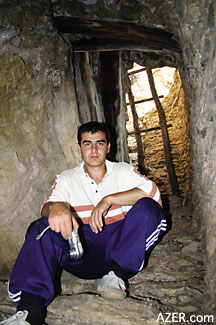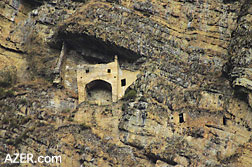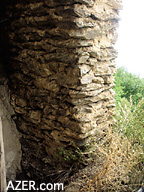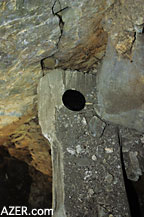|
Related Articles
Even 14 years after gaining independence from the Soviet Union, tourism has still not developed very much in Azerbaijan, especially throughout the countryside. Ronnie Gallagher, who worked in Baku for a number of years and who still maintains close ties, suggests there are still many delightful places to explore, including Parigala, a castle-like structure built into the side of a rock cliff in western Azerbaijan. Hardly anything is known about this monument except the legend that has grown up around its name "Fairy Castle". Here's what Gallagher discovered when he attempted the ascent this past summer.
Left: Parigala (Fairy Castle), is a mysterious monument at least several centuries old. It is located in the Caucasus Mountains in northwestern Azerbaijan near Zaqatala. No one knows who built it, when, what its purpose was, or when and why it was abandoned. Only legends exist in oral traditions about Parigala. Right: Close-up photo of Parigala. The site is quite inaccessible even for the most intrepid of mountain climbers. The main structure contains three rooms each with a window. Note the doors carved into the rock cliff to the right and a bit lower than the monument. This is a separate structure with two additional rooms that connect to the castle via a walled walkway, which is very difficult to see from photos. Photos: Ronnie Gallagher Parigala Legend Even its name - Parigala - is shrouded in mystery. The word combination of "Pari" and "Gala" literally means "Fairy Castle". However, "Pari" is also a female name and may be linked to a folk tale, perhaps of a later period. The legend that is told about Parigala dates back to the days of Chingiz Khan, (1155-1227, and sometimes spelled Ghengiz or Genghis Khan). The story goes that he chose one of the daughters of a local ruler for his bride. When she was asked if there was anyone more beautiful, she named her sister Pari. However, when Pari heard that the Mongol warlord was interested in taking her into his harem, she organized for a castle to be built in the side of the mountain cliff. However - as the story goes - with Chingiz camping at the foot of the mountain and the prospect of her capture imminent, Pari threw herself down from the castle, falling to her death on the rocks below. In that sense, this story resembles the legend often told about Baku's Maiden Tower. Although this tale is an interesting bit of folklore; sadly, no one knows whether there is any truth to it. This is the only information known about this castle. Everything about its history seems to have been lost over time. Off the Beaten Track Perhaps one of the reasons so little is known about Parigala is because it is located so far off the beaten track. You'll need a four-wheel drive vehicle to navigate the narrow tracks leading up to it. Then you must climb another 40 minutes up a very slippery slope to a steep, leaf-covered and forested hillside. That's the easy part. Most people don't venture any further because it's too hazardous. A strong word of caution: you really should be in fairly good physical shape and have a good sense of balance at great heights if you attempt to go further. Fortunately, about 30 years ago, Mammad made the grueling climb somewhat more manageable by erecting a makeshift ladder and providing a slim tree trunk at the base, which enables one to shimmy up into the enclosed stairwell.  Left: Muhuma Davudov, who lives in the community and who served as the mountain guide for Ronnie Gallagher. Muhuma's father Mammad, a famous wrestler in his youth, was probably the last person to scale Parigala 30 years ago. The monument is almost impossible to scale. Gallagher did not manage to get close to the castle structure itself. Photos: Ronnie Gallagher Whoever built the castle certainly knew what they were doing. It's obvious that they had defense in mind because the location is so steep and so inaccessible. It would be suicidal for any would-be attacker to navigate past the difficult and narrow stairwell and pathway leading up to the castle. Anyone could hide above the route and easily fend off any determined assault because of the skillful design of the defensive walls, the narrow angles - not to mention the extreme difficulties in climbing the steep ascent. The enclosed stairway is a remarkable feat of engineering and extends upward about 40 meters. It begins at the bottom of a crevice in the limestone rock strata that has been widened to provide access from the hillside. This wall has four openings, which provide access to sunlight. The wall was built of rough limestone bricks, cemented together with a very strong mortar that binds the structure together and makes it adhere to the mountainside. Also there are a number of well-preserved, wooden beams (possibly oak) built into the stairway for support. Unfortunately, at the top of the enclosed stairwell, there is one section that has separated from the rock face, perhaps as a result of an earthquake. Frankly speaking, progress beyond this point is more than a bit scary. It's definitely not a climb for the faint-hearted as it requires incredible agility and mountaineering skills. While I never managed to get very close to the castle structure itself, Mammad told me that there are three rooms, each with windows, in the main structure. Connected to the castle by walled walkways, but slightly more difficult to see, is a separate structure with two additional rooms. From the photographs taken from below, this structure appears to have been strengthened by the support of retaining walls and transverse stone blocks. Overall, the castle has been remarkably well constructed and preserved over the centuries. It shows evidence of being occupied for many years from the polished nature of the limestone rock, which leads to the entrance stairwell. With the exception of some damage to the stairwell walls, Parigala has weathered the passing of years surprisingly well with very little damage. With proper archaeological study and research, surely it would be possible to coax out many of the castle's secrets. This would be beneficial both the Azerbaijani people as well as a contribution to the world heritage. Indeed, this site could be of significant historical value for Azerbaijan. Studying it might serve to fill in some gaps related to its pre-Islamic past. The obvious questions to investigate include: Who built it? When? Why? And why was it abandoned? For now, the answers are only speculative. The age of the castle should be easy to determine since there are wooden beams built into the walls. The wood could be dated, using radiocarbon dating or dendrochronology, a technique that examines the growth of tree ring patterns in relationship to known climatic conditions. Determining the structure's age would be the first step in placing it into its proper contextual time frame. This should enable historians and archeologists to be able to reconstruct some of its history from known events. Historically, most significant structures are built either for military or religious purposes. Given the small size of Parigala, it is obvious that only a limited number of people could survive there, especially since there doesn't seem to be a natural source of water. On the other hand, it could be that the castle had limited strategic value and that it served a religious function.
From left to right: All Photos: Ronnie Gallagher While it may be fascinating
to think about a maiden seeking refuge there; it's more likely
that the shelter served as some sort of monastery for monks or
priests during the early Christian centuries when persecutions
were prevalent and protection so vital - just like many of the
mountaintop monastery retreats in Europe. Ronnie Gallagher worked as Environmental
Manager for BP in Azerbaijan from 2000-2003. During his free
time, he explored much of the countryside, enjoying the natural
history and searching for evidence of ancient settlements. His
observations on stone circles, cup marks and cart ruts, have
been published in earlier issues of Azerbaijan International.
Ronnie is currently on assignment in Angola but returns to Azerbaijan
whenever possible. Contact Ronnie Gallagher: gallagher_ronnie@yahoo.co.uk.
|








